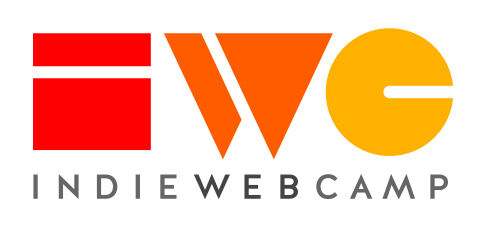2014/SF/start
Getting started on the IndieWeb (without tears) was a session at IndieWebCamp SF 2014.
Notes archived from: https://old.etherpad-mozilla.org/indiewebcamp-start
When: 2014-03-07 12:00
Participants
 Ryan Barrett
Ryan Barrett- ...
Notes
7 March 2014 Getting started on the IndieWeb (without tears)
 Ryan Barrett reffered everyone to: web hosting
Ryan Barrett reffered everyone to: web hosting
1. Get your own domain
Steven Geluso: History: I saw Geocities, etc.
Scott Jenson: when i went back to when i got my first domain it was this scary thing of cname hacking. the number of effort i had to go through and issues was immense. along with my wife
i envision a webpage: what's your domain name and what do you want to do with it? it strikes me as a possible business oppeortunity or a statement
what's keeping us from literally making an indeiweb signup site.
johannes: the questions is what is the code that runs on that site?
Scott jenson: step one is that i need a car
step two is to drive that care
caseorganic: yes, and oyu need to know how to drive that car once you have it
you can use tumblr and have your own domain name
johannes: i cannot take tumblr somewhere else brecause it's not portable but i can take wordpress somewhere else
DanGilmor: would there be greater leverage in geting in touch with one of the better registrars and saying "can you do this for us?"
Scott jenson: we want any domain to be able to go to any server, including servers in your home. the registrar is a good first step but might not be indie enough
DanGilmor: the registrar i use is totally into indieweb principles
Steve Geluso: what do you mean by any domain going to any server ?
Jenson: register for a domain, then you can choose what host. then you have your domain and it does all the work for you and moves all of the data around.
Amber Case: you've got your registrar, hosting, DNS -- if ytou move stuff it's a mess
Jenson: Docker: using this as a container
Caseorganic: like how shipping containers made it possible for modern supply chains. ships, trains and trucks.
Johannes: gave example of cloudstore - moves all of the data, all of the code and the DNS. https://cldstr.com/
Nice user interface on top that normal people can use.
caseorganic: indiebox, sharing data with doctors over 24 hours, concerned about how long cldstore will last
temporary auth
indie box is all open source, you can maintain it yourself
making plugins for an indiebox and the marketplace model
amber case: Wordpress in early days was messy, then it got modular -- that's a good model people can participate in WP at many different levels with or without writing code many participation layers
Jenson: Ark OS
Caseorganic: the original possiblity of Twitter was thas that you could give a feed to anything
caseorganic: cpanel, I just want to run a forum, why do I have to deal with security issues? great, there's a domain and a panel and one-click install!
Johannes: the cost for all of these things is in maintennce, not installation
Jenson: we're going between the issue of "getting a box" and "filling a box"
Caseorganic: I like the idea of Lego components. Everything works together and has self contained pieces with endpoints you can easily plug into everything
Jenson: if i upgrade from Tumblr or CloudStore to Ark OS. why should me experimenting with Ark OS be tramautic?
scott ros: what's the difference between what we're talking about and going to a server and buying serverspace and setting it all up yourself?
caseorganic: it's in the maintenance and portability. I ran a blogger, exported that to wordpress, exported that to static HTML. it's not LEGO-like.
Johannes: and this goes back to aaron talking about the connectivity between all of these things. the web we had in the past didn't work for this potential.
caseorganic: X10 home automation via IRC
Johannes: business models don't match technologies, you can't serve ads via RSS
caseorganic: what didn't make money back in the day will make money today, pets.com is viable now. the same will be with what we're doing now. we're nerdy now, but the public will catch up in 2-3 years.
Jenson: sustainability. how is this sustainable?
caseorganic: discussions on wikimedia, minecraft, IRC sustainability. there's only one guy that works on waybackmachine. what happens when he quits?
how can we make something that doesn't require having a centralized or decentralized office? how can we make something that just persists, like IRC.
Geluso: where are people coming from, what are they going to do with indieweb? is the point about getting data off private servers to public servers? once I've added rel="me" links to my domain what do I do next?
caseorganic: explains indiewebify.me. you can use indieauth
jenson: add a step 1.5 to indiewebify.me, get a LAMP stack.
rosenberg: you can't go from 0 to 60. people are confused about choosing between linux distros
caseorganic: I went to namecheap, I signed up for hosting, it's a bit weird to have hosting and domain at the same place. people are used to seeing nice websites, then they panic when they can't make them.
kyle mason: that's sort of what digital ocean was all about
johannes: we need to show people, if they do this then they get this, if they do this then they get this. show what each step will allow people to do
dan gillmor: this is something that we could help express with the comic book
scott jenson: what's our goal? are we trying to get the male cheerleader to self-publish?
dan gillmore: where are we trying to get people to go?
scott jenson: have you seen coder? it's a web server, editor combination
amber case: stairstep growth not explosive growth
johannes: let's take time to write a few paragraphs about who these people are, what communities are we reaching?
scott jenson: there are bloggers, and there are people that don't publish
scott rosenberg: people that have been running blogs for a long time and are not self-hosted
dan gillmore: people that have
ryan suerted: talking about medium
Stairstep Model: Right now there's a small group of people that are comfortable with running servers, writing code. The IndieWeb is being built by these people across a small number of sites. They are the current adopters of Indie Web.
The next level is people who have a domain name and know there's a problem that they're not owning their data on silos. This will be our focus next; we'll ignore everybody else aka "the general public".
Anybody who blogs on their own site.
Do you publish on your own site? Not people with Wordpress.com sites. People who have been running blogs on their own site people who have hosting accounts right now and know what that means and are beginning to apprecate that this is a problem and want to liberate themselves and their content
Caseorganic: it's much better to have a smaller group the next group that's comfortable with adding rel=me links to ttheir site
Wave 1: Current Indieweb 20140307
Comfortable building CMS
Keywords: SSH, Server key, OAuth
Reason why Bridgy is so important Literally BRIDGES the gap between Wave 1 IndieWeb and Wave 2 IndieWeb communities
What's motivating me now?
Needs: Archiving capture/mirror/track engagement/interaction across the web independence
Wave 2: Has a domain and runs their own website - comfortable clicking a button on Fantastico and installing something. building with a CMS thriugh a hosting company managing their blog Keywords: cPanel, Fantastico, Scriptaculous
Wave 3: Runs a wordpress blog Keywords:
Wave 4: Runs a tumblr on their own domain Keywords:
Wave 5: Uses Twitter/Facebook Keywords:
The Open Web
Jenson: list the specific providers and how easy they are:
For these next 1000 people it's go to these systems .
Domain Hover.com
Hosting Birdhouse Hosting http://birdhouse.org
scott rosenberg: important to get instructions right for people who can follow them -- like telling us that the link for indieauth in googleplus needs to be in the "other profiles" section of your profile page or it won't work
